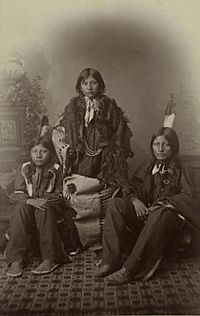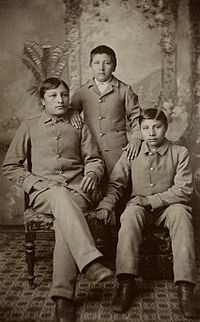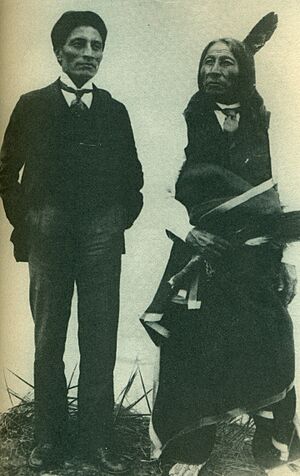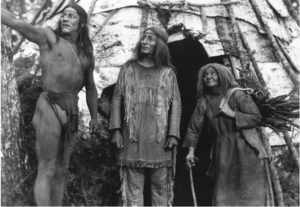Chauncey Yellow Robe facts for kids
Quick facts for kids
Chief
Chauncey Yellow Robe
|
|
|---|---|
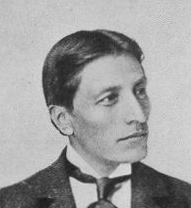
Photograph circa 1900
|
|
| Born |
Canowikacte Yellow Robe
January 15, 1867 Sičháŋǧu Oyáte territory, known today as the Rosebud Indian Reservation, in southern South Dakota
|
| Died | April 8, 1930 (aged 63) |
| Nationality | Sioux, American |
| Other names | Timber Chief Yellow Robe |
| Family | Tasinagi (father); Tahcawin (mother); Lillian Belle Springer (wife); Rosebud, Chauncina and Evelyn (daughters) |
Chief Chauncey Yellow Robe (born Canowikacte lit. kill in woods Yellow Robe, c. 1869) was an important Sioux leader. He was a teacher, speaker, actor, and Native American activist. His birth name, Canowicakte, meant "kill in woods." He was also called "Timber" when he was young.
Chauncey Yellow Robe went to the Carlisle Indian School. This was a special Native American boarding school. He finished school there in 1895. He worked as a teacher for 32 years for the Bureau of Indian Affairs. This government group worked with Native American tribes.
Later in his life, he was in movies and at important events. He even adopted President Calvin Coolidge into the Sioux tribe. He also acted as Chief Chetoga in the 1930 movie The Silent Enemy.
He was the father of Rosebud Yellow Robe, who became a famous storyteller and writer.
Contents
Growing Up and Going to School
Chauncey Yellow Robe was born in the Sičháŋǧu Oyáte territory. This area is now called the Rosebud Indian Reservation in southern South Dakota. He was likely born on January 15, 1867.
He was the first child of Tahcawin (lit. female deer). His mother was a talented artist and the niece of the famous leader Sitting Bull. His father, Tasinagi, was a hunter and a Chief. He was later known as Yellow Robe because of his brave actions in war.
Chauncey said his childhood was mostly about hunting and fishing. He also chased buffalo across the plains. These plains stretched across South Dakota, North Dakota, Nebraska, Wyoming, and Montana.
Carlisle Indian School Experience
His father sent Chauncey and his younger brother to the Carlisle Indian Industrial School. This school was in Carlisle, Pennsylvania. His father felt good about this after talking to Chief Standing Bear, whose son also went there.
Chauncey started at the school in 1883. He did not know English and had no formal schooling. He became known as Chauncey there. He later said that he was taken to the school at age fifteen. He wore his full Native American clothes. He had long hair, a painted face, feathers, moccasins, and a blanket. He did not know any English words. Yet, in a few years, he became an independent American citizen. He believed that educating Native Americans was not a bad thing for American society.
In 1893, Chauncey Yellow Robe helped with the Carlisle School's display. This was at the Chicago World's Fair. The display was called "Into Civilization and Citizenship." It showed pictures of students and other items. He was also chosen to represent North American Indians at the World's Fair.
He finished school with good grades on April 1, 1895. He learned the skill of tailoring.
Career and Fighting for Rights
After graduating, Yellow Robe became a teacher for the government's Indian School Service. He likely moved to Rapid City, South Dakota to start teaching. After one year, he became a "disciplinarian," which meant he helped keep order. He left this job in 1902 but returned in 1905.
From about 1896 to 1913, he taught and helped with discipline in Rapid City, South Dakota. He probably worked at the Rapid City Indian School. This school was built in 1898 for Native American children from the Northern plains. It included children from the Sioux, Northern Cheyenne, Shoshone, Arapaho, Crow, and Flathead tribes. It was one of the boarding schools run by the Bureau of Indian Affairs.
Around this time, he met Lillian Belle Sprenger. She was a volunteer nurse at the Rapid City Indian School. Lillian was from a Swiss-German family. She was born in Minnesota in 1885. Chauncey and Lillian married in 1905. They had three daughters: Rosebud, Chauncina, and Evelyn Robe.
His daughter Rosebud Yellow Robe later became a famous storyteller, teacher, and writer.
Speaking Out Against Stereotypes
In October 1914, Yellow Robe spoke at a conference in Rapid City, South Dakota. He gave a speech called "The Menace of the Wild West Show." This speech was written down and printed in The American Indian Magazine.
Yellow Robe strongly criticized how Native Americans were shown in popular shows. He said: "All these Wild West Shows make the Indian look worse than he ever was. They take away his dignity and unique spirit... We see a monument of the Indian in New York harbor. It is a memorial of his vanishing race. The Indian does not want such a monument, for he is not yet dead. The name of the North American Indian will not be forgotten as long as the rivers flow and the hills and mountains shall stand. Even though we have made progress, we have not disappeared."
In 1916, Yellow Robe also wrote about his childhood in The American Indian Magazine.
President Coolidge Joins the Tribe

In 1927, President Calvin Coolidge and First Lady Grace Coolidge spent several months on vacation in South Dakota. They met with different Native American tribes. On August 4, 1927, they came to Deadwood, South Dakota. They were there for the town's annual rodeo.
The Lakota tribe held a special ceremony. They made Coolidge a member of their nation. This was to thank him for helping pass the Indian Citizenship Act of 1924. This act gave Native Americans full U.S. citizenship. Hundreds of Lakota people came to the event. Chauncey Yellow Robe led the ceremony. His childhood friend Henry Standing Bear and his daughter Rosebud Yellow Robe were also there.
Chauncey Yellow Robe gave President Coolidge the Lakota name Wanblee-Tokaha (lit. Leading Eagle). He "adopted" him into the Lakota Sioux tribe as a "High Chieftain." After giving him the name, Yellow Robe said: "Today, Mr. President, you are a one-hundred percent American by adoption into an aboriginal tribe. Good White Father, we welcome you into our tribe. We hope you will continue to guide this great nation on to a still greater destiny."
After this, Rosebud Yellow Robe gave Coolidge a feather war bonnet and yellow skins. She gave Grace Coolidge moccasins. Pictures of this event were on the front pages of major newspapers. These included The New York Times, Los Angeles Times, and The Baltimore Sun. They were also made into postcards. That same year, Rosebud Yellow Robe moved to New York to start an acting career.
Acting in a Film
Around 1928, Yellow Robe met Molly Spotted Elk at the American Museum of Natural History. She introduced him to the directors of a film, Douglas Burden and William Chandler. They immediately offered Yellow Robe the role of Chief Chetoga.
At first, he said no. This was because movies often showed Native Americans in a bad way. He went back to Rapid City. But his daughter Rosebud Yellow Robe convinced him to take the part. She was told by the director that the film would show "an honest depiction of Native American life." With this promise, Yellow Robe changed his mind. He traveled to Arnprior, Ontario and Lake Temagami to film the movie.
Around 1928, he played Chief Chetoga in the historical drama film The Silent Enemy. The movie came out in 1930. The American Museum of Natural History helped fund the film. It showed a complex story of Ojibwe tribal life before Europeans arrived. Yellow Robe played one of the main roles. He also helped with the movie's technical details. The cast was said to be only Native Americans.
Yellow Robe gave the film's spoken introduction. He greeted the audience, praised the story, and shared his hopes for the Ojibwe tribe's future.
His picture was printed in 1928 in National Geographic magazine. The caption said, "His Forebears Ruled the Dakotas."
Later Life and Impact
On April 8, 1930, Chauncey Yellow Robe passed away from pneumonia. This happened at the Rockefeller Institute Hospital. The New York Times newspaper said his death ended "a picturesque and notable career."
His family sent his body back to Rapid City. His funeral was held at the city's Masonic Temple. He was buried next to Lillian Belle Sprenger in Mountain View Cemetery.
After Yellow Robe's death, President Calvin Coolidge said, "He was a born leader. He understood that the future of Native Americans was connected to the future of our country. His loyalty to his tribe and people made him a very patriotic American."
Images for kids
-
Studio portrait of Wounded "Richard" Yellow Robe, Henry Standing Bear, and Chauncey Yellow Robe the day after they entered the school on November 15, 1883.
-
August 4, 1927: Yellow Robe inducting Calvin Coolidge (left) into the Lakota tribe in Deadwood, South Dakota, with daughter Rosebud Yellow Robe (center)


